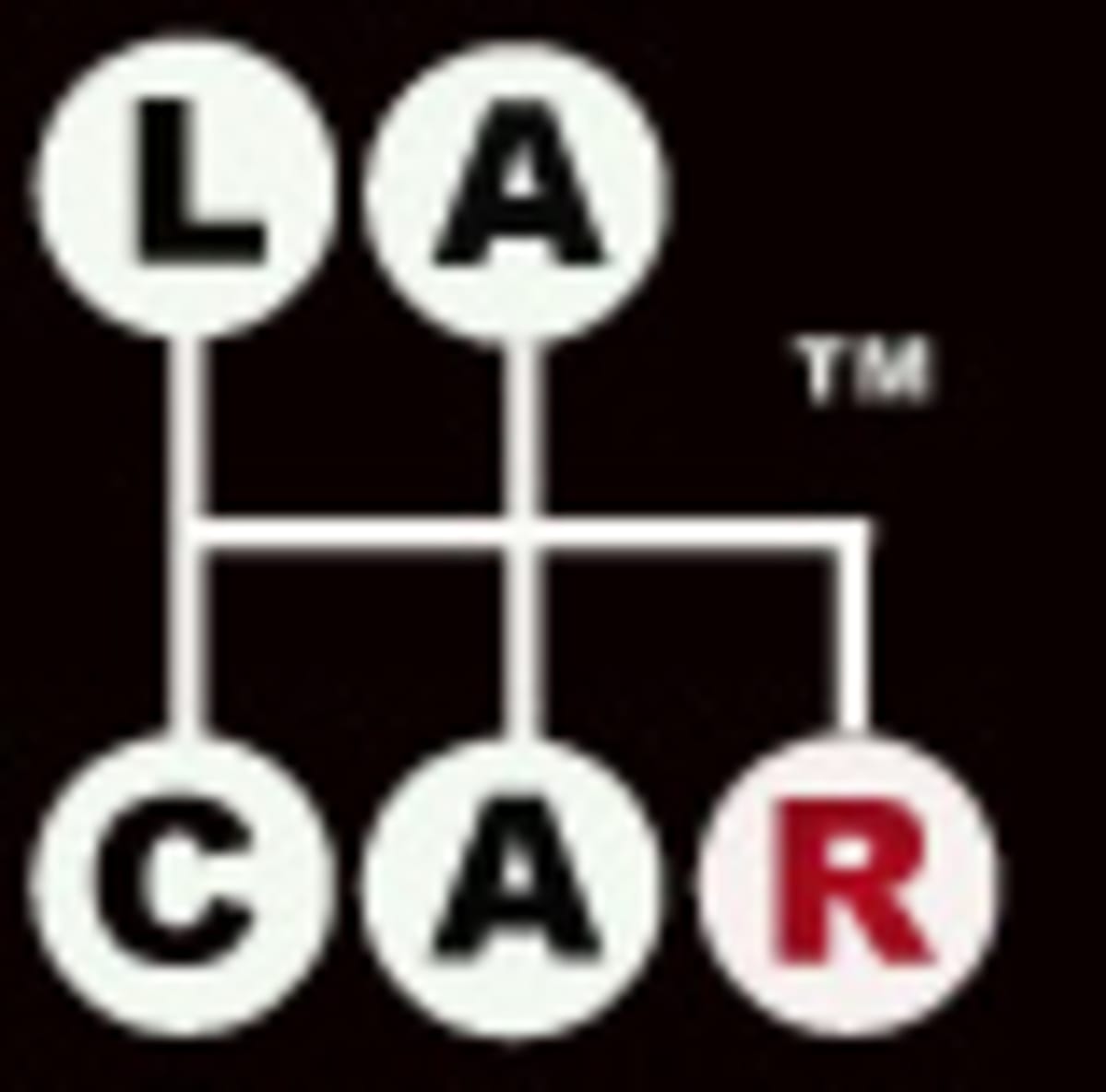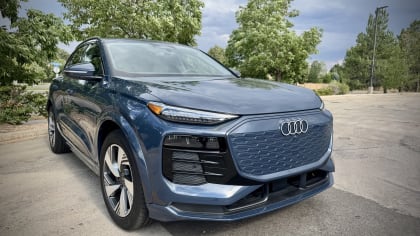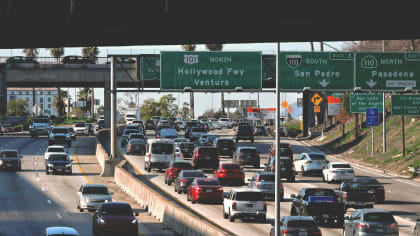REVOLVER
This article is from our archives and has not been updated and integrated with our "new" site yet... Even so, it's still awesome - so keep reading!
Published on Mon, May 4, 2009
By: The LACar Editorial Staff

EVOLUTION X
From the front, you notice the large front fascia opening which Mitsubishi
defines as the "shark nosed" effect. The opening is used to cool both the
radiator and front-mounted intercooler. The front end flows with the new sharp,
thin front HID headlight design, as the sides of the front fascia flows in to
the side of the vehicle where it meets up with the flared front fenders and
boxed rear fenders closely resembling that of the Lancer Evolution World Rally
Championship cars. As mentioned, the new body style of the Evolution also has
reasoning behind it - i.e., aerodynamics. Some of the more key aero
improvements: The front bumper's bottom is lowered, the front wheel arch
incorporates the air dam and lip, the smoothed, inclined surface of the fender,
the side air dam works as an airflow straightener, rear spoiler has been
optimized and the angle varies to have maximum efficiency, and even the
taillights have a sharp edge - all these improvements are there to decrease drag
and lift on the new Evo X. Work under the vehicle was also done to straighten
the air and decrease drag and lift while provided cooling for the brakes and
transfer case. The hood is optimized with an inlet (NACA duct) to provide
cooling to the turbo and outlets were designed to exhaust engine heat as well s
decrease lift. All-in-all, the new body and styling of the new Mitsubishi
Evolution X has form and function built it to make it one of the best-designed
cars in a long time
From the Inside
The interior of the new MR has as much refinement as the exterior. The new
Recaro seats not only fell as comfortable as sitting in a non-racing seat, but
still keep you planted from sliding in the corners. They also now include a side
airbag which is the first of its kind in the Evolution models. The steering
wheel and shift handle are wrapped in leather to provide a sportier feel.
Metallic trim now highlights the shifter bezel, steering wheel-mounted controls
as well as the paddle shifters. The gauge panel sports a dual-hood gauge panel
with a large speedometer and tach while in between is the multi information
display with a large LCD screen and uses two-tone yellow and red characters to
display all the information on the vehicle. The different information displayed
ranges from the TC-SST status and S-AWC status, also displays a 16-segment
coolant temp with warning, main odometer, trips and a driving computer. The
driving computer displays things such as cruising distance with remaining fuel,
average speed, average fuel economy and instantaneous fuel economy.
To top it off, the tested MR is upgraded with the technology package, which
included a Rockford-Fosgate audio system with sub, SIRIUS satellite radio, a 30
gig hard drive navigation system with a 7.5 inch touch screen and music server,
Bluetooth capability for your mobile phone and FAST key entry system. The MR is
also equipped with 11 pounds of additional sound insulation. Making this one of
the most enjoyable and comfortable sports car available on the market today.
The Power Within
The first all-new Evo engine since its launch over 16 years ago
The 4B11 is a 2.0L DOHC twin-scroll turbocharged four cylinder engine, and
features a new aluminum die-cast cylinder block with direct-acting valve train
in the cylinder head. This new package plus the removal of the balancer shafts
reduced the engine weight by 27.5 pounds over the old cast iron 4G63. Some may
think that an aluminum cylinder block compromises the strength of the engine.
However, the bearing caps are now fastened by four bolts each, a semi-closed
deck was designed to reduce deformation of the cylinders, and a ladder structure
is used to increase strength. The ladder structure, along with a timing chain
and hydraulic engine mounts, reduce the noise and vibration of the engine.
Mitsubishi's MIVEC (Mitsubishi Innovative Valve-Timing Electronic Control) has
been around over the years. With the new 4B11, however, the MIVEC got an upgrade
as well being equipped on both the intake and exhaust sides of the engine.
Through the new MIVEC system, a new optimized intake manifold, and new intake
and exhaust ports Mitsubishi was able to increase the efficiency of the motor
and lower emissions. A new set of injectors and an optimized fuel line pressure
improved the atomization of fuel at both the emission and performance side of
the engine.
As you stare down at the engine, you may notice that the turbocharger is no
longer on the front side of the engine. The cylinder head now has a rear exhaust
layout and a high-performance metal catalyst for a quicker "light off". New
longer reach spark plugs were also designed to be used in the 4B11 increasing
the water jacket size around the combustion chamber for better cooling this
combined with the new aluminum cylinder block reduced the fire-contact surface
temperature by approximately 122 degrees Fahrenheit, in turn reducing the
thermal load on the cylinder head. Through these enhancements, plus a new
optimally shaped turbo compressor wheel, straight type intake system and a
larger diameter exhaust system, Engine response was improved by up to 18 percent
over the 4G63. Even a higher efficiency alternator was used on the new 4B11 to
increase performance and lower fuel consumption and emissions. The 4B11 now
produces 291 horsepower at 6500 rpm and 300 pound-feet of torque at 4000 rpm -
making this engine one of the highest horsepower-to-liter production engines in
the world at 145.5 per liter. In summary, the new 4B11 generates more
horsepower, increased engine response, lower emissions and increased reliability
over the old 4G63.
The Transmission
On and off the track, the Mitsubishi Evolution MR's new first-ever automated
manual transmission and advanced six-speed Twin-Clutch Sportronic Shift
Transmission (TC-SST) makes a bad driver good and a decent driver better on and
off the track. The TC-SST is essentially a manual transmission that can select
two gears at a time. One gear is engaged by one of the two wet multi-plate
clutches, and the other is pre-selected, awaiting to be engaged by the second
clutch. Through this upshifts and downshifts can occur in a fraction of a
second. Although the time is perceived to be slightly longer, this is so the
engine management can blip the throttle to match the engine and transmission
speeds. The TC-SST acts like two separate transmissions to accomplish this. The
odd and even gears are actually on two different input shafts and linked by a
transfer gear. The TC-SST has three different modes of operation normal, sport
and s-sport. In the normal mode the transmission shifts well like an automatic,
but with a twist the shifts are quick and seamless providing better fuel
efficiency than a conventional torque converter automatic. The second mode would
be sport mode. In this mode the transmission uses higher shift points and
quicker shifting to deliver that sporty feeling of a manual transmission. The
last mode is S-Sport Mode which is used for situations like track driving. It's
basically the sport mode on steroids. It acts exactly how you would drive on a
track holding the revs out higher, downshifting where you want to and upshifting
where you want to. This selection is also where the launch control of the
vehicle is held. The Mitsubishi Evolution X MR transmission does exactly what
you want it to do. Perform like an automatic when you want it to and opens up to
a full race transmission at the track.
Handling & Braking
The Mitsubishi Evolution X MR is one of the best handling cars I have ever
driven on the street stock, while still maintaining comfort for everyday
driving. The turn in, body roll, everything about the car screams performance.
The X offers 56 percent better torsional rigidity and 50 percent better bending
rigidity over the previous IX. This is done through various things one being the
use of high-tensile and super high-tensile builds in strength, while the use of
aluminum in many parts lowers the weight in others. In the new Evolution, the
roof, hood, front fenders and both front and rear bumper beams are aluminum as
well a number of key suspension component also reduce unsprung weight. Earlier
we mentioned the wider fenders and body line of the new X - this reflects in
some dimensions: The wheelbase is one inch longer now at 104.3, and the front
and rear track are increased by 1.2 inches to a measurement of 60.8 these are
over the older IX model.
The new X also uses Mitsubishi's next-generation Reinforced Impact Safety
Evolution unibody design. This new highly rigid structure uses a new
high-tensile steel not found on earlier models in turn the stiffer structure of
the body is reinforced also by additional bracing allowing a more aggressive
suspension tuning and still improves ride quality. Some of these enhancements
include a unique front strut tower bar, V-Shaped rear seat brace and additional
spot welding. Earlier we talked about the new rear mounted turbo system this
allowed Mitsubishi to create a new flat front crossmember this new flat
crossmember can directly receive lateral loads from the front lower arm. This
flat front crossmember is based off the Outlander, although it has been
strengthened in many key parts to increase rigidity by 40 percent over the IX
and new forged suspension knuckles reduce knuckle twisting caused by varying
road surfaces. New hub bearings are also used and provide a 7 percent increase
in camber stiffness and 23 percent in lateral stiffness.
The MR still uses the MacPherson strut suspension although the struts are
replaced with Bilstein shocks and Eibach non-linear springs. The front sway bar
has been increased 1 mm over the IX (to bring it to 25 mm) and the rear is also
up 1 mm (to 23 mm). Front suspension geometry has also been reworked to provide
increased caster angle which equates to more negative camber at higher steering
angles. The MR equipped with new 18-inch BBS forged wheels reduce the weight by
a little over two pounds and wheel over the cast-alloy wheels on the GSR model
and are wrapped with a low profile Yokohama Advan A13C which provide better
cornering performance. With the new low profile tires and increased caster trail
of 3.1 mm over the IX improves the steering response and turn in of the vehicle.
The rear of the vehicle was not forgotten, receiving numerous changes like the
front. Improved joint rigidity in the rear suspension and rear shelf of the
vehicle as well as a raised trunk floor to accommodate a straighter crossmember.
Through a more rigid crossmember and newer hub bearings the rear camber and toe
stiffness was increased by 50 percent. For stopping power the MR uses a Brembo
brake system. The front rotor diameter is 13.8-inches, with a four-piston
caliper, and the rear is 13 inches, with a two-piston caliper. The MR also uses
a new two-piece construction on the brake system to reduce weight by 2.9 pounds
per wheel. The brakes also incorporate the S-ABS system, which detects steering
inputs, lateral-G and vehicle speed to apportion pressure to the four corners
independently to increase steering response while braking. The new suspension
and brakes on the new Mitsubishi Evolution X MR make this a true sports car in
all ways except for the number of doors it has. I have yet to see anyone come
close to it for performance.
Parting Shot
With the new improvements in body design for aerodynamics, engine power and
reliability, transmission performance and suspension Mitsubishi has built the
best four-door performance car out on the market. They have raised the bar so
high it almost scares me what they might release next in the Evolution lineup,
and what other manufacturers must do to catch up to this performance machine. As
I said before, this car will take a bad driver and make them a good driver and
for that matter will even take season veterans and give them a run for their
money.
SUMMARY JUDGMENT
For a single vehicle to be both a daily driver and a true track contender, the
new Evolution X MR is practically perfect in every way.
Editor's Note: Greg Nakano is the Director of Special Projects at Advanced
Engine Management (AEM)
For more information about Mitsubishi products, go to
www.mitsubishimotors.comÂ
SPECIFICATIONS
Name of vehicle:
2009 Mitsubishi Lancer Evolution X MR
Price:
$32,990 - base GSR
$38,290 - base MR
$41,535 as tested - MR, with Technology Package (includes Rockford-Fosgate audio
system with subwoofer, SIRIUS satellite radio, 30 gigabyte hard drive,
navigation system with a 7.5-inch touch screen and music server, and FAST key
entry system)
EPA estimated fuel economy (city/highway):
17/22 mpg
Engine:
4B11 T/C 2.0L MIVEC I4 turbocharged/intercooled, DOHC 16-valve, Mitsubishi
Innovative Valve-timing Electronic Control system (MIVEC) aluminum with
multi-point injection
Horsepower @ RPM (BHP):
291 @ 6500
Torque @ RPM (lb-ft.):
300 lb.-ft. @ 4400
Transmission:
Six-speed Twin-Clutch Sportronic Shift Transmission (TC-SST) automatic with
sequential manual sport and super sport modes and available launch control
Drive configuration:
All-wheel drive
Steering:
Hydraulic power-assisted rack-and-pinion
Suspension:
Front MacPherson strut (inverted strut) with forged aluminum control arms,
Eibach springs and Bilstein shock absorbers, front stabilizer bar (25 mm)
Rear Multi-link with forged aluminum control arms, Eibach springs and Bilstein
shock absorbers, rear stabilizer bar (23 mm)
Brakes:
Front ventilated 13.8 inch disc with 4-piston caliper, two-piece rotor for
weight reduction
Rear 13-inch ventilated disc with 2-piston caliper
Anti-lock brake system: 4 sensor, 4 channel Sports ABS with EBD
Wheels and tires
Wheel type: BBS® forged aluminum alloy
Wheel size: 18 x 8.5 in. 5JJ
Tire type: Yokohama ADVAN asymmetrical performance tread P245/40R18 93Y
Dimensions
Length: 177 inches
Width: 71.3 inches
Height: 58.3 inches
Curb Weight (lbs./kg) GSR MR: 3594/ 1630
Performance
0-60 mph: 5.3 seconds
Quarter-mile elapsed time: 13.9 seconds
















